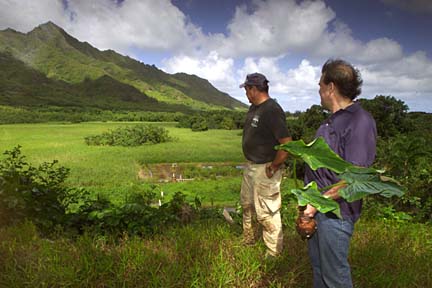

|
Raising Cane Rob Perez |
1874 foreclosure law
took heavy farm tollWhen historian Robert Stauffer started sifting through thousands of pages of old documents that a trust company clerk had saved from the trash bin, he knew he had come across an information gold mine.
It just wasn't clear at the time how valuable the find would be.
It's clear now.
Based on those documents, many of them written in Hawaiian, Stauffer produced ground-breaking research that is detailed in his new book, "Kahana: How the Land Was Lost."
The book basically exposes the major role that an obscure but controversial mortgage foreclosure law played in the widespread loss of lands by native Hawaiians in the late 1800s and early 1900s.
DENNIS ODA / DODA@STARBULLETIN.COM
Ron Johnson and Robert Stauffer enjoy the view in Kahana Valley. Ron hand-cleared the area below to raise taro as did his family before him. Stauffer's new book uses previously unexamined documents to detail how an 1874 state law facilitated the loss of native Hawaiian land.
It's a state law that still is being used today, resulting in what critics claim is the unfair taking of people's homes and property, much like what happened to native Hawaiians decades ago.
Stauffer's book is bound to raise eyebrows and add to the debate over the law, which consumer advocates have unsuccessfully tried to get repealed at the Legislature in the past few years.
Stauffer's work provides insight, backed by meticulous research, into the question of how numerous Hawaiian families lost their homesteads to non-Hawaiians starting around the end of the 19th century.
"That was the $64,000 question," Stauffer said in an interview. "I was completely surprised by the answer."
He found the answer in the 14 feet of documents, some more than a century old, that had been given to the state archives in the late 1970s or early '80s by a local trust company.
A company clerk who was told to dispose of the records instead contacted the archives office to ask if the state was interested in keeping them. Once at the archives, the papers sat on a shelf largely untouched until Stauffer began his research years later.
Included in the documents was an amazing and unique find -- a complete historical record of land transactions for Kahana Valley (now a state park) that date to the Great Mahele of the mid-1800s, when the Western concept of private property ownership, including land titles, was introduced to Hawaii.
DENNIS ODA / DODA@STARBULLETIN.COM
Clinton "Nana" Gorai stands in an invasive plant growth on the shores of the fish pond in Kahana Bay. A new book called "Kahana: How the Land Was Lost," sheds new light on the Great Mahele of the mid-1800s, when numerous Hawaiian families lost their homesteads to non-Hawaiians.
Documents involving other large populated parcels in Hawaii exist, but unlike with the 5,000-acre Kahana Valley, those records tend to have big gaps, particularly in the 1800s.
Based on the Kahana documents, which included 2,500 transactions that Stauffer analyzed with a computer database, he discovered that Hawaiians started losing their land less than a decade after the nonjudicial foreclosure law was passed by the Hawaiian Legislature in 1874.
In Kahana, the foreclosure law contributed directly or indirectly to Hawaiians losing almost all their homesteads, a trend that played out throughout the islands, according to Stauffer. By 1920, more than 90 percent of the homesteads -- among the most valuable land in Hawaii -- was owned by non-Hawaiians.
The 1874 law created a system in which lenders could foreclose on property without any judicial oversight and often without the knowledge of the homeowner, according to Stauffer.
Mortgages at the time usually came with onerous terms, including high interest rates and short repayment periods, and those terms all but ensured that the subsistence farmers who borrowed money using their land as collateral would run into default problems, his research found.
Based on today's dollars, the records indicated that the farmers had to earn about $12,000 a month, or $144,000 a year, to afford a typical loan from that period, Stauffer found.
It's no surprise, he added, that the Hawaiians ended up losing their land, even though many learned to use the legal system to try to resist the land takings.
Stauffer said the Westerners who pushed for the foreclosure law knew what the likely ramifications would be -- a native people dispossessed from their land.
"History tells us this is a bad law," he said. "It doesn't exist to help people. It exists to help people lose their homes."
Stauffer's research tends to dispel the commonly held view among historians that Hawaiians quickly lost their land after the mahele and were basically naive victims of a Western land system they didn't understand.
Author Gavan Daws, who co-wrote the 1985 tome, "Land and Power in Hawaii," describes Stauffer's book as a benchmark on a topic of paramount importance in Hawaii.
"Stauffer's work significantly and permanently raises the bar for all future historical study of land in Hawaii," he says on the book's cover jacket.
The nonjudicial foreclosure law has been substantially revised since 1874, but its critics still contend the measure lacks adequate standards and gives little due process to homeowners.
People who fall behind on their mortgages can end up losing their homes in as little as a few months, with no judicial oversight.
"The whole thing is a fraud, a giant rip-off," said attorney Gary Dubin, who has asked the Hawaii Supreme Court to overturn the law. The court has yet to rule on several challenges Dubin has filed.
Lender representatives say consumers have sufficient protections under their mortgage agreements, including requirements for plenty of notice to correct loan defaults.
If the foreclosure law had such serious flaws, they add, it would have been successfully challenged during the more than 100 years it has been on the books.
But after the wave of nonjudicial foreclosures that hit Hawaiians through the early 1900s, the law apparently was little used until a few years ago, largely because title companies were reluctant to provide insurance for such cases.
Once the title concerns were addressed, lenders started using the nonjudicial process more frequently, attracted by the less cumbersome requirements compared with the court-supervised procedures.
"Our analysis has confirmed that the nonjudicial foreclosure process is quicker, easier and less costly than the judicial process," said Freddie Mac, one of the biggest players in the mortgage industry. In a 1999 memo, Freddie Mac noted that the average nonjudicial foreclosure in Hawaii can be processed in as little as four months, compared with eight to 10 under the standard procedures.
But critics argue that the nonjudicial process is stacked against consumers and isn't even allowed in nearly half the states.
Said Stauffer: "We have enough of a problem with home ownership in Hawaii without bringing in this cancer from the past."
See the Columnists section for some past articles.
Star-Bulletin columnist Rob Perez writes on issues
and events affecting Hawaii. Fax 529-4750, or write to
Honolulu Star-Bulletin, 500 Ala Moana Blvd., No. 7-210,
Honolulu 96813. He can also be reached
by e-mail at: rperez@starbulletin.com.

